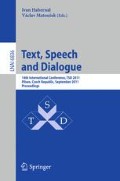Abstract
We study the role of sizes of neural networks (NNs) in TRAP (TempoRAl Patterns) and HATS (Hidden Activation TRAPS architecture) probabilistic features extraction. The question of sufficient size of band NNs is linked with the question whether the Merger is able to compensate for lower accuracy of band NNs. For both architectures, the performance increases with increasing size of Merger NN. For TRAP architecture, it was observed, that increasing band NN size over some value has not further positive effect on final performance. The situation is different when HATS architecture is employed – increasing size of band NNs has mostly negative effect on final performance. This is caused by merger not being able to efficiently exploit the information hidden in its input with increased size. The solution is proposed in form of bottle-neck NN which allows for arbitrary size output.
Access this chapter
Tax calculation will be finalised at checkout
Purchases are for personal use only
Preview
Unable to display preview. Download preview PDF.
References
Hermansky, H., Ellis, D.P.W., Sharma, S.: Tandem connectionist feature extraction for conventional HMM systems. In: Proc. ICASSP 2000, Turkey (2000)
Sharma, S.R.: Multi-stream approach to robust speech recognition, Ph.D. thesis, Oregon Graduate Institute of Science and Technology (October 1999)
Hermansky, H., Sharma, S., Jain, P.: Data-derived nonlinear mapping for feature extraction in HMM. In: Proc. Workshop on Automatic Speech Recognition and Understanding, Keystone (December 1999)
Athineos, M., Hermansky, H., Ellis, D.P.W.: LP-TRAP: Linear predictive temporal patterns. In: Proc. ICSLP 2004, Jeju Island, KR, pp. 949–952 (October 2004)
Tyagi, V., Wellekens, C.: Fepstrum representation of speech signal. In: Proc. of IEEE ASRU, San Juan, Puerto Rico, pp. 44–49 (December 2005)
Jain, P., Hermansky, H.: Beyond a single critical-band in TRAP based ASR. In: Proc. Eurospeech 2003, Geneva, Switzerland, pp. 437–440 (2003)
Grézl, F., Hermansky, H.: Local averaging and differentiating of spectral plane for TRAP-based ASR. In: Proc. Eurospeech 2003, Geneva, Switzerland (2003)
Zhu, Q., Chen, B., Grézl, F., Morgan, N.: Improved MLP structures for data-driven feature extraction for ASR. In: Proc. INTERSPEECH 2005, Lisbon, Portugal (September 2005)
Ellis, D., Morgan, N.: Size matters: An empirical study of neural network training for large vocabulary continuous speech recognition. In: Proc. ICASSP 1999, Phoenix, Arizona, USA, pp. 1013–1016 (March 1999)
Bourlard, H., Morgan, N.: Connectionist Speech Recognition: A Hybrid Approach. Kluwer International Series in Engineering and Computer Science, vol. 247. Kluwer Academic Publishers, Dordrecht (1994)
Fukunaga, K.: Introduction to Statistical Pattern Recognition, 2nd edn. Academic Press Professional, Inc., San Diego (1990)
Hain, T., et al.: The AMI system for the transcription of speech meetings. In: Proc. ICASSP 2007, Honolulu, Hawaii, USA, pp. 357–360 (April 2007)
Chen, B., Zhu, Q., Morgan, N.: Learning long-term temporal features in LVCSR using neural networks. In: Proc. ICSLP 2004, Jeju Island, KR (October 2004)
Zhu, Q., Stolcke, A., Chen, B., Morgan, N.: Using MLP features in SRI’s conversational speech recognition system. In: Proc. INTERSPEECH 2005, Lisbon, Portugal (September 2005)
Grézl, F., Karafiát, M., Kontár, S., Černocký, J.: Probabilistic and bottle-neck features for LVCSR of meetings. In: Proc. ICASSP 2007, Honolulu, Hawaii, USA, pp. 757–760 (April 2007)
Author information
Authors and Affiliations
Editor information
Editors and Affiliations
Rights and permissions
Copyright information
© 2011 Springer-Verlag Berlin Heidelberg
About this paper
Cite this paper
Grézl, F. (2011). The Role of Neural Network Size in TRAP/HATS Feature Extraction. In: Habernal, I., Matoušek, V. (eds) Text, Speech and Dialogue. TSD 2011. Lecture Notes in Computer Science(), vol 6836. Springer, Berlin, Heidelberg. https://doi.org/10.1007/978-3-642-23538-2_40
Download citation
DOI: https://doi.org/10.1007/978-3-642-23538-2_40
Publisher Name: Springer, Berlin, Heidelberg
Print ISBN: 978-3-642-23537-5
Online ISBN: 978-3-642-23538-2
eBook Packages: Computer ScienceComputer Science (R0)

